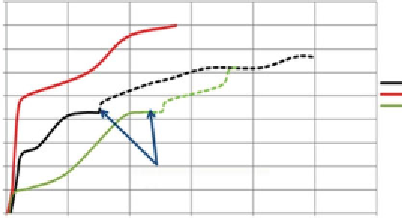Environmental Engineering Reference
In-Depth Information
SMART EOR for Mixed Wettability Core-plugs at Ambient Conditions
18.00
16.00
14.00
12.00
10.00
8.00
6.00
4.00
2.00
0.00
0.0
100% Sequential surfactant flooding
50% Sequential surfactant flooding
Simultaneous Surfactant flooding
Application of EK
10.0
20.0
30.0
40.0
50.0
60.0
Number of injected pore volumes
Figure 4.8
Displacement efficiency of mixed to oil-wet core plugs by EK-assisted
surfactant flooding (at room temperature)
original displacement efficiency factor in oil-wet core plugs, while produc-
ing 28% of original displacement efficiency factor in water-wet core plugs.
4.5
Electrokinetics-Assisted Waterflooding with
Low Concentration of HCl
Haroun
et al
. (2013) conducted experiments using a low concentration
of hydrochloric acid (up to 1.4% strength) in EK-assisted waterflooding
(e.g., see figures 4.9 and 4.10) in carbonates. The results demonstrate an
exponential relationship between the acid concentration and permeabil-
ity enhancement. This indicates that the rate of increment of permeability
enhancement is dropping with increased acid concentration as the acid
properties change significantly with increasing concentration (Harris
et al
.,
1966). This is due to the significant increase in production of fines and clay
colloidal particles that block the pore throats, reducing the permeability.
Therefore, there might be an optimum acid concentration at which there is
a maximum permeability enhancement (approximately 1.2% HCl), which
can be determined if experiments are conducted on a wide range on tight
core plugs.
An increase in voltage gradient to 2 V/cm enhances permeability only
by 36%. This may be due to the fact that an increase in voltage gradient
increases the EK driving force reducing the contact time between the rock
and acid. Driving the acid faster lowers the rate at which the electro-chemi-
cally enhanced reactions can take place. A voltage gradient of 1 V/cm gives
















Search WWH ::

Custom Search